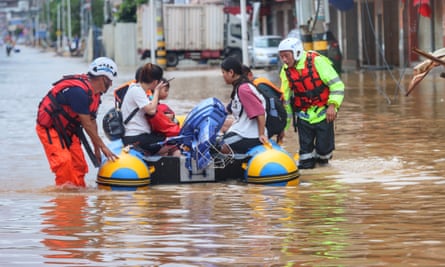Beijing has recorded its heaviest rainfall this year as the remnants of Typhoon Doksuri passed through China’s capital, forcing more than 31,000 people to evacuate their homes in the city, according to state broadcaster CCTV.
Heavy rain continued to fall in Beijing as well as in Hebei, Tianjin and eastern Shanxi as Doksuri dissipated over northern China, the China Meteorological Administration said.
Doksuri is one of the strongest storms to hit China in years and caused widespread flooding over the weekend in the southern province of Fujian, driving hundreds of thousands of people from their homes.
Average rainfall in Beijing overnight reached 140.7mm (5.5in), with the maximum recorded rainfall in Fangshan area hitting 500.4mm (19.7in), according to the city’s observatory. Rains in the southern and western areas were expected to be heavier early on Monday.

There was no reported damage or casualties, state media said.
Work was halted on more than 4,000 construction sites, almost 20,000 buildings were inspected for damage, and scenic spots in the city were closed, media reported.
While Doksuri continues to taper off, forecasters warned that typhoon Khanun was approaching and was set to strike China’s densely populated coast this week.
Authorities said Khanun could inflict further damage to corn and other crops that had already been hit by Doksuri.
Doksuri made landfall on Friday, downing power lines and uprooting trees, affecting about 880,000 people in coastal Fujian and forcing more than 354,400 to evacuate and resettle, and causing more than 478m yuan (£52m) in direct economic losses, state media reported.
In Doksuri’s wake, social media posts showed emergency workers clearing fallen trees and landslides, and people wading in thigh-high flood waters.
Before hitting China, the typhoon roared through Taiwan and the northern Philippines, where rain and strong winds that led to the capsizing of a ferry that left at least 25 people dead.













